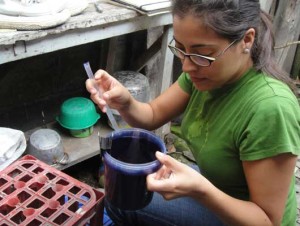Dengue’s Climate Connection
This article is a modification from the press release issued by SUNY’s Upstate Medical University.
A study by an international team of researchers led by Anna M. Stewart Ibarra, Ph.D., at the Center for Global Health & Translational Science (CGHATS) at SUNY Upstate Medical University, has provided public health officials with information that will help decrease the risk of dengue, a life-threatening mosquito-borne viral disease that is now one of the fastest spreading tropical diseases globally.
Stewart Ibarra spoke on this research at the International Research Institute for Climate and Society’s monthly climate briefing. Her team discovered that certain household risk factors, combined with changes in rainfall and minimum temperature, could be used to predict the presence and abundance of the mosquito that transmits dengue fever.
IRI’s Ángel Muñoz is one of the coauthors on the study, “Dengue Vector Dynamics (Aedes aegypti) Influenced by Climate and Social Factors in Ecuador: Implications for Targeted Control,” published this month in PLOS ONE. Muñoz analyzed the spatial patterns of rainfall, temperature and moisture transport in the region of study, using the output of a high-resolution climate model. Such analyses help researchers better understand the influence of climate on dengue transmission, he says. Once such dynamics are better understood it opens up the possibility for seasonal climate forecasts to play a role in developing an early warning system for dengue fever in coastal Ecuador, Muñoz says.
The World Health Organization regards dengue as an increasingly important challenge that needs to be addressed. IRI is a Pan American Health Organization/World Health Organization Collaborating Center on Early Warning Systems for Malaria and other Climate Sensitive Diseases.

Anna Stewart Ibarra inspects an ovitrap in the patio of a study household to look for Aedes aegypti mosquito eggs. Ovitraps were monitored over a period of eight months to estimate Aedes aegypti populations, the mosquito that transmits the disease dengue fever.
Dengue fever is a public health threat throughout the tropics and is now emerging as a threat in parts of the southern U.S. It is a viral disease transmitted to people primarily by the Aedes aegypti mosquito, a mosquito that reproduces in containers with standing water in and around people’s homes. The virus cannot be spread directly from person-to-person. There is no vaccine or drug currently available, although dengue vaccine trials are ongoing at SUNY Upstate and elsewhere.
At her talk, Stewart Ibarra said that this week health authorities confirmed the first case of locally contracted dengue in New York. “This startling finding highlights that dengue, a disease previously thought to be restricted to the tropics, is also emerging in Florida and other U.S. regions,” she says.
Current research by Stewart Ibarra and other colleagues aims to identify the impact of climate, population, and other influences on the spread of the disease in Ecuador. They have found, for example, that the effect of rainfall on disease risk is complex, and depends on the local social conditions. For instance, increasing rainfall can increase the standing water available for mosquito breeding. Droughts, however, can also increase dengue risk in areas with poor access to piped water supply, if the drought conditions lead people to store more water, also providing the necessary breeding habitat. Heavy rainfall events can also flush juvenile mosquito larvae from containers, decreasing dengue risk above certain rainfall thresholds.
Until a vaccine becomes available, mosquito control is the only way to control the spread of the disease. “The findings from this study will help public health officials develop mosquito control campaigns that target high-risk households and mosquito habitats in each season,” said Stewart Ibarra.
The team conducted this study from 2010 to 2011 in the city of Machala, located in southern coastal Ecuador, an area where dengue is prevalent. They monitored mosquito populations and conducted household surveys to identify dengue risk factors, such as water storage practices, access to piped water and knowledge and perceptions of dengue. They also looked at local climate factors, since previous studies by Stewart Ibarra and Dr. Rachel Lowe, at IC3 (Barcelona, Spain) had demonstrated that the El Niño-Southern Oscillation influences dengue transmission in this region.
“Our findings can help reduce the burden of dengue in this particular region by conducting focused interventions that target high-risk households and containers in each season and by developing predictive models using climate and non-climate information,” said Stewart Ibarra.
The results from this study also have contributed to the development of a multi-year investigation of climate, the dengue virus, and Aedes aegypti in the same region.
Stewart Ibarra and Muñoz’s coauthors on the publication are: Sadie J. Ryan, Ph.D., of CGHATS at SUNY Upstate, SUNY College of Environmental Science and Forestry, and the University of KwaZula-Natal, Pietermaritzburg, South Africa; Efrain Beltran, M.D., and Mercy Silva, M.D., of the National Service for the Control of Vector-Borne Diseases, Ministry of Health, Machala, Ecuador; and Raul Mejia of the National Institute of Meteorology and Hydrology, Guayaquil, Ecuador.

You must be logged in to post a comment.